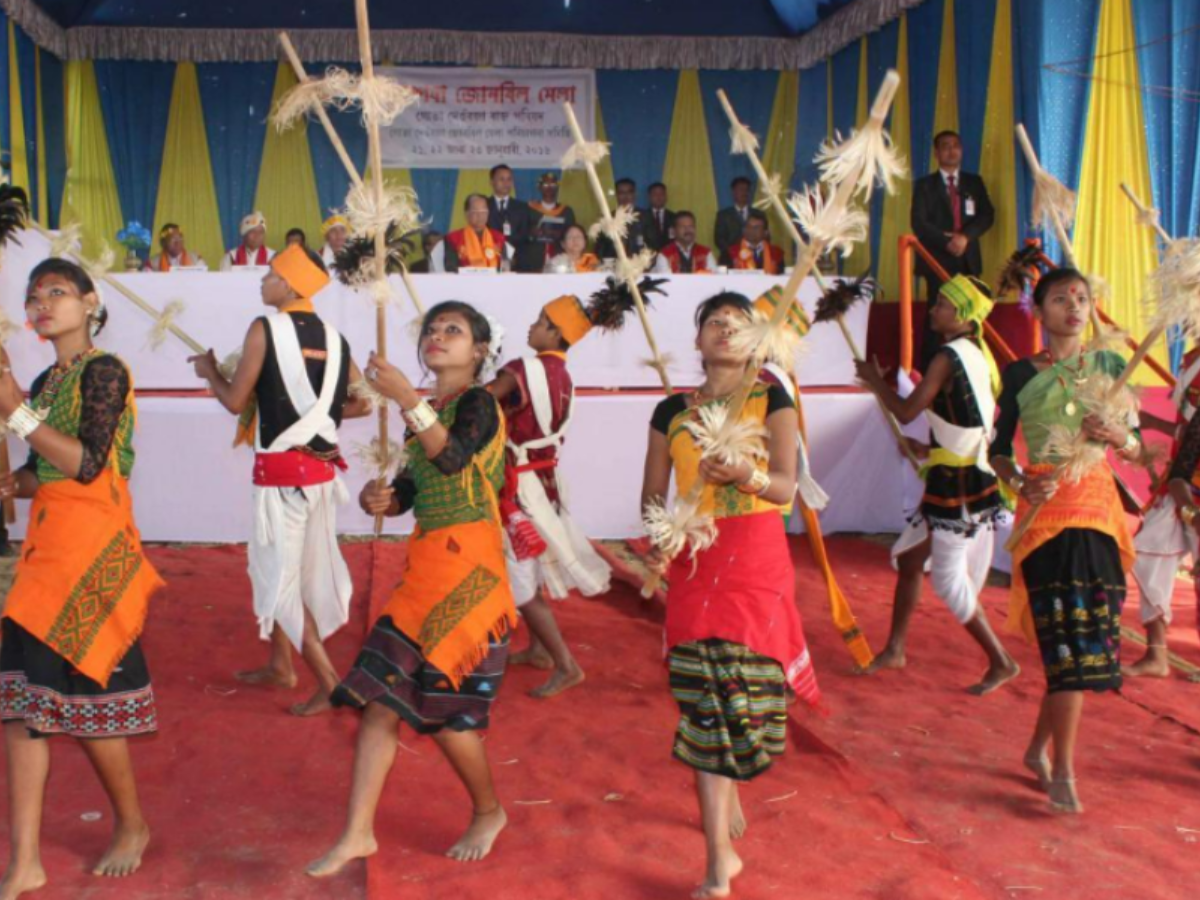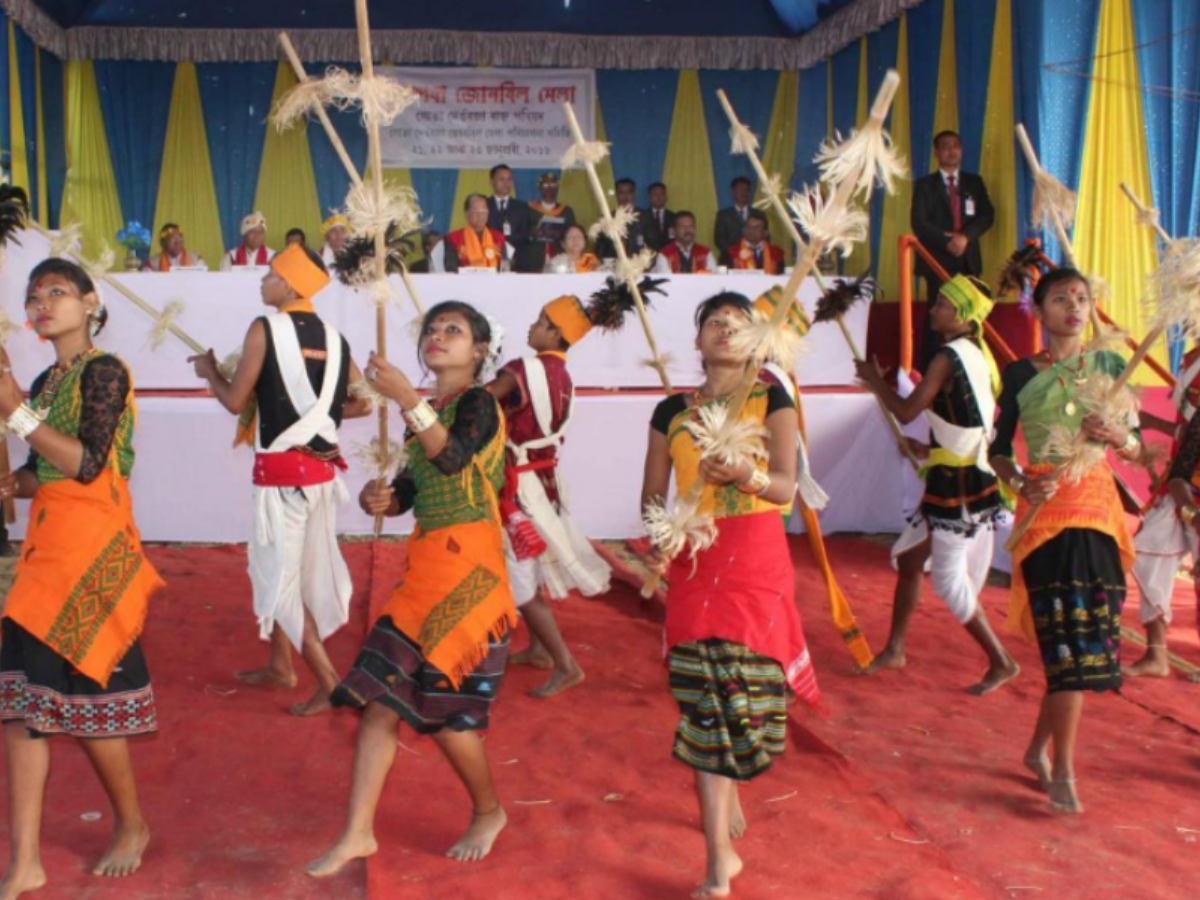State
Tribe Name
Art Type
short description
Jon Beel Mela is a grand traditional fair organized every winter at Jonbeel, near Jagiroad, about 32 km from Guwahati, Assam. The fairs have been held here since time immemorial and are interestingly one of the last remaining institutes where the barter system is still in practice. This cultural event derives its strength mainly from the Tiwa tribe and other tribes like the Karbis, Khasis, and Jaintias who come from the hills of Meghalaya and barter goods with local people without the use of money.
The fair commences with the fire-worship ritual (Agni Puja), conducted by tribal communities to bless mankind. Following Agni Puja, a large bazar is set up for the tribal groups to exchange commodities such as vegetables, spices, traditional herbs and crafts with the plains people, thus establishing an economic and cultural milieu.
The royal visit from Gova Raja, the Tiwa King, and newly crowned nobles is one of the major attractions of the Jon Beel Mela. It is here that the king entitles himself to tax his subjects, thereby enabling the ancient system of governance practiced by the Tiwa communities to linger in memory. In addition, cultural programs comprising traditional dance and folk songs are a medium for various tribal and non-tribal groups to promote unity and coexistence.
The Jon Beel Mela acts as a fair yet remains a lively cultural festival that conserves the legacy of the Tiwa tribe, thereby solidifying ties between the hill and plain communities. An intimidating symbol of unity, trade, and cohabitation, this centuries-old practice retains its significance in present-day Assam.
The fair commences with the fire-worship ritual (Agni Puja), conducted by tribal communities to bless mankind. Following Agni Puja, a large bazar is set up for the tribal groups to exchange commodities such as vegetables, spices, traditional herbs and crafts with the plains people, thus establishing an economic and cultural milieu.
The royal visit from Gova Raja, the Tiwa King, and newly crowned nobles is one of the major attractions of the Jon Beel Mela. It is here that the king entitles himself to tax his subjects, thereby enabling the ancient system of governance practiced by the Tiwa communities to linger in memory. In addition, cultural programs comprising traditional dance and folk songs are a medium for various tribal and non-tribal groups to promote unity and coexistence.
The Jon Beel Mela acts as a fair yet remains a lively cultural festival that conserves the legacy of the Tiwa tribe, thereby solidifying ties between the hill and plain communities. An intimidating symbol of unity, trade, and cohabitation, this centuries-old practice retains its significance in present-day Assam.
Thumbnail

Filter Postion
Right
Filter Background
Off
Theme
Filter Header Image

content
Image

description
Jon Beel Mela is a grand traditional fair organized every winter at Jonbeel, near Jagiroad, about 32 km from Guwahati, Assam. The fairs have been held here since time immemorial and are interestingly one of the last remaining institutes where the barter system is still in practice. This cultural event derives its strength mainly from the Tiwa tribe and other tribes like the Karbis, Khasis, and Jaintias who come from the hills of Meghalaya and barter goods with local people without the use of money.
The fair commences with the fire-worship ritual (Agni Puja), conducted by tribal communities to bless mankind. Following Agni Puja, a large bazar is set up for the tribal groups to exchange commodities such as vegetables, spices, traditional herbs and crafts with the plains people, thus establishing an economic and cultural milieu.
The royal visit from Gova Raja, the Tiwa King, and newly crowned nobles is one of the major attractions of the Jon Beel Mela. It is here that the king entitles himself to tax his subjects, thereby enabling the ancient system of governance practiced by the Tiwa communities to linger in memory. In addition, cultural programs comprising traditional dance and folk songs are a medium for various tribal and non-tribal groups to promote unity and coexistence.
The Jon Beel Mela acts as a fair yet remains a lively cultural festival that conserves the legacy of the Tiwa tribe, thereby solidifying ties between the hill and plain communities. An intimidating symbol of unity, trade, and cohabitation, this centuries-old practice retains its significance in present-day Assam.
The fair commences with the fire-worship ritual (Agni Puja), conducted by tribal communities to bless mankind. Following Agni Puja, a large bazar is set up for the tribal groups to exchange commodities such as vegetables, spices, traditional herbs and crafts with the plains people, thus establishing an economic and cultural milieu.
The royal visit from Gova Raja, the Tiwa King, and newly crowned nobles is one of the major attractions of the Jon Beel Mela. It is here that the king entitles himself to tax his subjects, thereby enabling the ancient system of governance practiced by the Tiwa communities to linger in memory. In addition, cultural programs comprising traditional dance and folk songs are a medium for various tribal and non-tribal groups to promote unity and coexistence.
The Jon Beel Mela acts as a fair yet remains a lively cultural festival that conserves the legacy of the Tiwa tribe, thereby solidifying ties between the hill and plain communities. An intimidating symbol of unity, trade, and cohabitation, this centuries-old practice retains its significance in present-day Assam.
Image Mode
landscape
promoted
Off
Verified
Off
